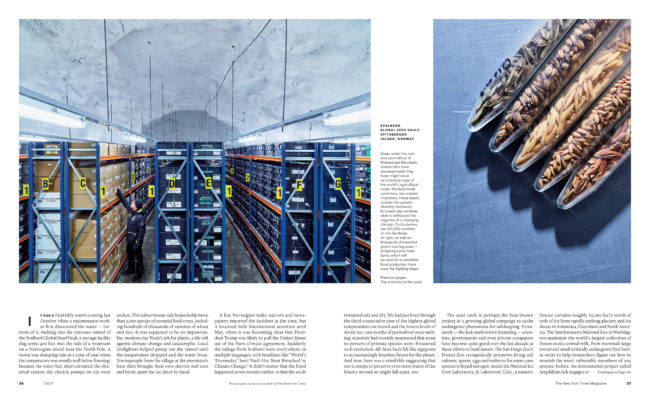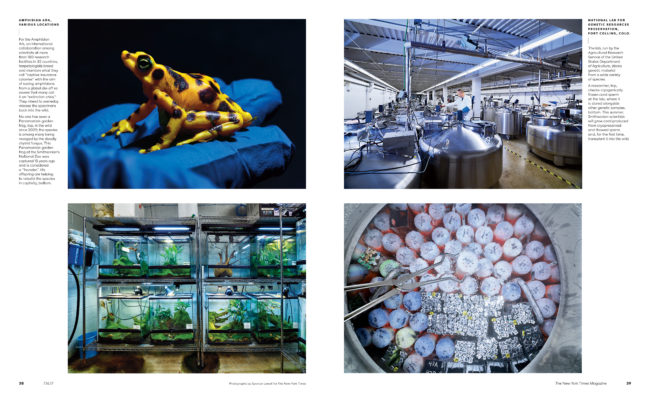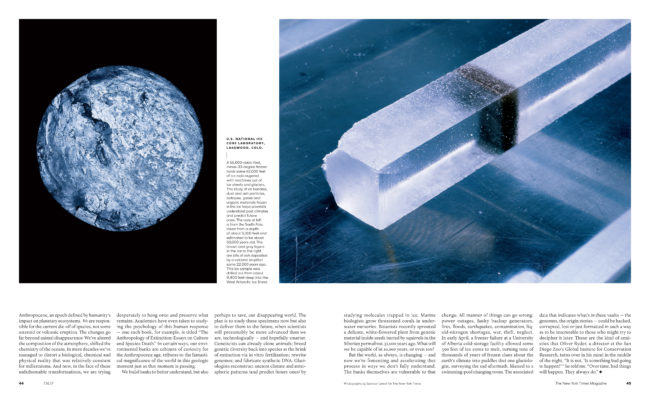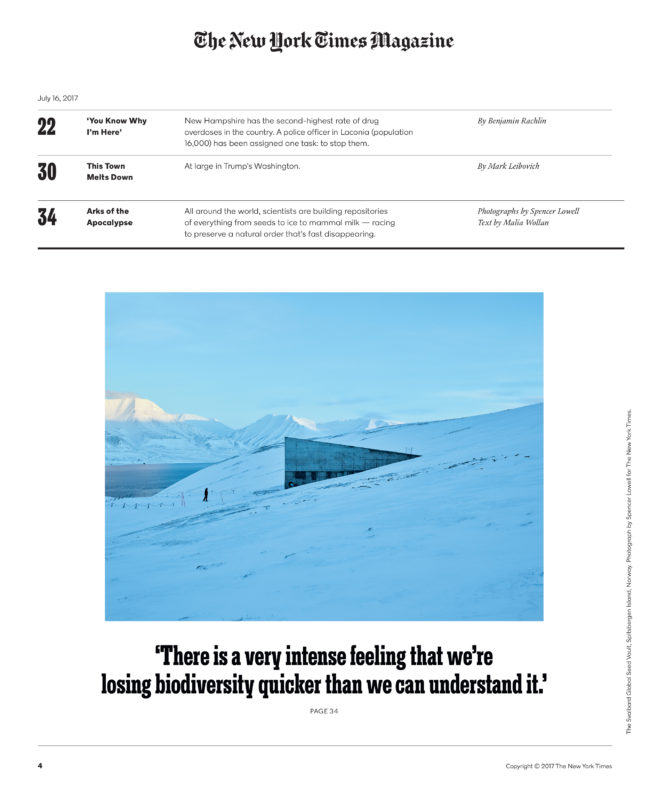The New York Times Magazine
Design Director: Gail Bichler
Art Director: Michael Willey
Deputy Art Director: Ben Grandgenett
Photographer Director: Kathy Ryan
Associate Photo Editors: Amy Kellner, Christine Walsh, Stacey Baker
Photographer: Spencer Lowell
Heidi: How difficult was it to get to the location considering how remote the seed vault was?
Spencer: The seed vault actually isn’t that remote once you get to the town of Longyearbyen, which is only a couple of connecting flights from LA. You can actually see the vault from the airport up in the mountainside. It has to be accessible because it’s opened up a few times a year for deposits to be made. The biggest difficulty was dealing with the -20 degree temperatures once I was actually at the vault.
What was your security clearance process for the vault?
After some googling, I emailed the press department at the Norwegian Ministry of Agriculture and Food and told them I was working on a project for the New York Times and wanted to photograph the vault. They wrote me back saying the vault was actually going to be open the following week for a deposit and let me know I was more than welcome to come. I booked my travel and was there the next week. I assume they looked at my website but besides that, there was no security clearance.
Did you have to wear protective gear considering how precious the subject matter was?
For the shoot at the seed bank, I was wearing an obscene amount of layers because of how cold it was so no additional protection was needed. I could bare my hands being out of my gloves for a few seconds if I needed to change my camera and light settings but all the actual shooting was with gloves on.
Regarding the frogs, the staff who handled them were wearing gloves but my assistant and I didn’t touch them ourselves so we didn’t need to wear anything protective. However, we did have to clean the bottoms of our shoes before entering the facility to make sure we didn’t drag in any contaminates.
The biggest safety concern on this project was the shoot with the orangutan, Batang and her baby, Redd. Because their DNA is so similar to ours, they’re actually susceptible to our diseases. So I had to get tested for Tuberculosis the week before the shoot, which luckily I didn’t have and the shoot would’ve been called off if I’d had even a slight cold. Ultimately I had to keep my distance and wear scrubs, a mask and gloves.
How long were you allowed in the seed bank?
I was allowed inside the vault for a total of about an hour between two visits. I also went back for another 3 visits to shoot the exterior.
How if at all do you think differently about food security, the fragility of life and our handprint on nature after this project; how did you try to convey that in your work?
We’re in the midst of the sixth mass extinction this planet has experienced. Four out of the other five extinctions were caused by climate change. The difference with what we’re seeing now is that human impact is changing the climate and it’s happening over decades rather than over thousands of years.
We know this because the ancient atmosphere is trapped in ice, which we’re able to extract from cores and study. I’ve seen a lot of images of ice melting but I felt like images of ice being artificially frozen would carry a powerful message. So, when Amy Kellner at NYT Mag asked me if I had any ideas for climate change stories, I pitched shooting the National Ice Core Lab. She was into the idea and asked if I could find any other facilities storing other natural assets. From there we collaborated on the story along with the writer, Malia Wollan until it became what it is.
It’s easy to forget that we’re a part of nature. We may live in cities and use tools but the fact is, we’re part of the natural world and are capable of causing natural disasters. With that said, we’re also capable of preventing them. That’s the main thing I learned from doing this project- that the hard work and dedication of a few can begin to counteract the mistakes our species is making as a whole.
How much underwater photography had you done prior to the reef shots?
I actually got certified to scuba dive for this job. Once I knew the coral nursery was going to be a component of the essay, I wanted to be the one to shoot it. I’ve always had a crippling fear of the ocean but I figured there wouldn’t be a better excuse to move through it. By the time I finished the scuba classes, the fear was gone.
Because I’d never shot underwater, I asked a photographer friend who has done some work underwater if he knew a good underwater assistant and he recommended a guy by the name of Mark Nakagawa. Mark is a seasoned diver and has worked in photo and video underwater so he helped me prep for the shoot and flew with me to the Keys to assist. We did four dives in the two days we were there and I couldn’t have done it without him.
Where there any technical obstacles for this project?
This was the most technically challenging project I’ve ever worked on because of the extreme shooting conditions. Between the below freezing temperatures, working underwater out in the ocean and being in the presence of living things that are either rare or no longer exist in the natural world, there was no margin for error. I like working with limitations because I’m forced to make decisions but this shoot left absolutely no room for second guessing.
What did you learn about your self creatively on this assignment?
I believe the creative process is in a constant state of refinement. I graduated from college almost a decade ago and I still strive for the same things that I did when I first started my career, I just have more clarity in vision and execution now. Creatively, my goal is to always keep things simple which I feel I was really able to achieve on this project because I didn’t have a choice. Passion for the subject matter plays a major role in my process and I find nothing to be more important than the future habitability of our planet.
What was the direction from the Times photo staff?
The whole project was a collaboration with Amy Kellner directly and Kathy Ryan and the rest of the photo department via Amy. With the exception of the Frozen Zoo in San Diego, I had multiple days at each location. So I would send Amy images with my notes from the first day’s shoot at each location and see if there was anything specific she wanted me to focus on the following day(s). If she asked for anything specific, I would do my best to deliver and regardless I would just shoot as much as possible. The clear stream of communication back and forth from the very beginning was the biggest contributing factor to the success of this project.







1 Comment
[…] the entire fascinating interview here and check out more of Spencer’s phenomenal work […]
Comments are closed for this article!